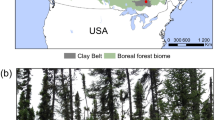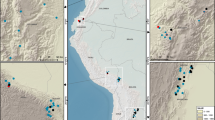Abstract
The circumpolar boreal biomes coverca. 2 109 ha of the northern hemisphere and containca. 800 Pg C in biomass, detritus, soil, and peat C pools. Current estimates indicate that the biomes are presently a net C sink of 0.54 Pg C yr−1. Biomass, detritus and soil of forest ecosystems (includingca. 419 Pg peat) containca. 709 Pg C and sequester an estimated 0.7 Pg C yr−1. Tundra and polar regions store 60–100 Pg C and may recently have become a net source of 0.17 Pg C yr−1. Forest product C pools, including landfill C derived from forest biomass, store less than 3 Pg C but increase by 0.06 Pg C yr−1. The mechanisms responsible for the present boreal forest net sink are believed to be continuing responses to past changes in the environment, notably recovery from the little ice-age, changes in forest disturbance regimes, and in some regions, nutrient inputs from air pollution. Even in the absence of climate change, the C sink strength will likely be reduced and the biome could switch to a C source. The transient response of terrestrial C storage to climate change over the next century will likely be accompanied by large C exchanges with the atmosphere, although the long-term (equilibrium) changes in terrestrial C storage in future vegetation complexes remains uncertain. This transient response results from the interaction of many (often non-linear) processes whose impacts on future C cycles remain poorly quantified. Only a small part of the boreal biome is directly affected by forest management and options for mitigating climate change impacts on C storage are therefore limited but the potential for accelerating the atmospheric C release are high.
Similar content being viewed by others
References
Adams J.M., Faure H., Faure-Denard L., McGlade J.M. and Woodward F.I.:1990,Nature,348, 711.
Apps M.J.: 1993,World Resource Review,5, 41.
Apps M.J. and Kurz W.A.:1991.World Resource Review,3, 333.
Birdsey R.A., 1992; Carbon Storage and Accumulation in US Forest Ecosystems,General Technical Report WO-59, USDA Forest Service, Washington, D.C., 51 pg.
Davis, M.B.: 1969,Ecology,50, 312.
Gignac L.D., Vitt D.H., Zoltai S.C., Bayley S.E.: 1991,Nova Hedwigia,51, 27.
Gorham E.: 1991,Ecological Applications,1, 182.
Graumlich L.: 1991,Ecology,72, 1.
Holling C.S.: 1992,Ecological Monographs,62, 447.
Kauppi P.E., Mielikäinen K., Kuusela K.: 1992,Science,256, 70.
Kivinen E. and Pakarinen P.;1981,Annales Acad. Scientiarium Fennicae A.III.123:1–28.
King G.A. and Nielson R.P.: 1992,Water, Air and Soil Pollution,64, 365.
Kolchugina T. P. and Vinson T. S.: 1993,Permafrost and Peraglacial Processes,4, 13.
Kurz W.A., Apps M.J., Webb T., and MacNamee P.: 1992, The Carbon Budget of the Canadian Forest Sector: Phase 1,ENFOR Information Report NOR-X-326, Forestry Canada Northwest Region, Edmonton, Alberta, 93 pg.
Nielson R.P., Lenihan J., and King G.A.: 1993, Global Biogeography and Biosphere Feedback During Climatic Change, in: Kanninen M. (ed),Carbon balance of world's forested ecosystems: towards a global assessment, Proceedings of Intergovernmental Panel on Climate Change Workshop, Joensuu, Finland, 11–15 May 1992, Publications of the Academy of Finland (in press).
Oechel W.C., Hastings S.J., Vourlitis G., Jenkins M., Riechers G., Grulke N.: 1993,Nature,361, 520.
Prentice I.C., Sykes M.T., Lautenschlager M., Harrison S.P., Denisenko O., and Bartlein P.J.: 1993,Biogeographical Letters, (in press).
Prentice K.C. and Fung I.Y.: 1990,Nature,346, 48.
Schlesinger W.H.: 1990,Nature,348, 228.
Shaver G.R., Billings D.W., Chapin III F.S., Giblin A.B., Nadelhoffer K.J., Oechel W.C., and Rastetter E.B.: 1992,BioScience,42, 433.
Sinitsin, A.: 1990,Forest Management,8, 6.
Smith T.M. and Shugart H.H.: 1993,Nature,361, 523.
Townsend A.R., Vitousek P.M. and Holland E.A.: 1993,Climatic Change,22, 293.
UN-ECE/FAO: 1992, The forest resources of the temperate zones: major findings, United Nations Economic Commission for Europe, Geneva, 32 pg.
Vitousek P.M.: 1991,J. Environ. Qual,20, 348.
Wullschleger S.D., Post W.M., and King A.W.: 1993, On the Potential for a CO2 Fertilization Effect in Forest Trees — An Assessment of 58 Controlled-Exposure Studies and Estimates of the Biotic Growth Factor, in: Woodwell G.M. (ed)Biospheric Feedbacks in the Global Climate System: Will the Warming Speed the Warming?, Oxford University Press (in press).
Zoltai S.C.: 1991,Holocene,1, 68.
Zoltai S.C.: 1993a,Arctic and Alpine Research, (in press).
Zoltai S.C.: 1993b,5th International Mire Conservation Group Excursion Guide, Swiss Federal Institute of Forestry Snow and Landscape Research, (in press)
Zoltai S.C. and Vitt D.H.: 1990,Quaternary Research 33, 231.
Rights and permissions
About this article
Cite this article
Apps, M.J., Kurz, W.A., Luxmoore, R.J. et al. Boreal forests and tundra. Water Air Soil Pollut 70, 39–53 (1993). https://doi.org/10.1007/BF01104987
Issue Date:
DOI: https://doi.org/10.1007/BF01104987




